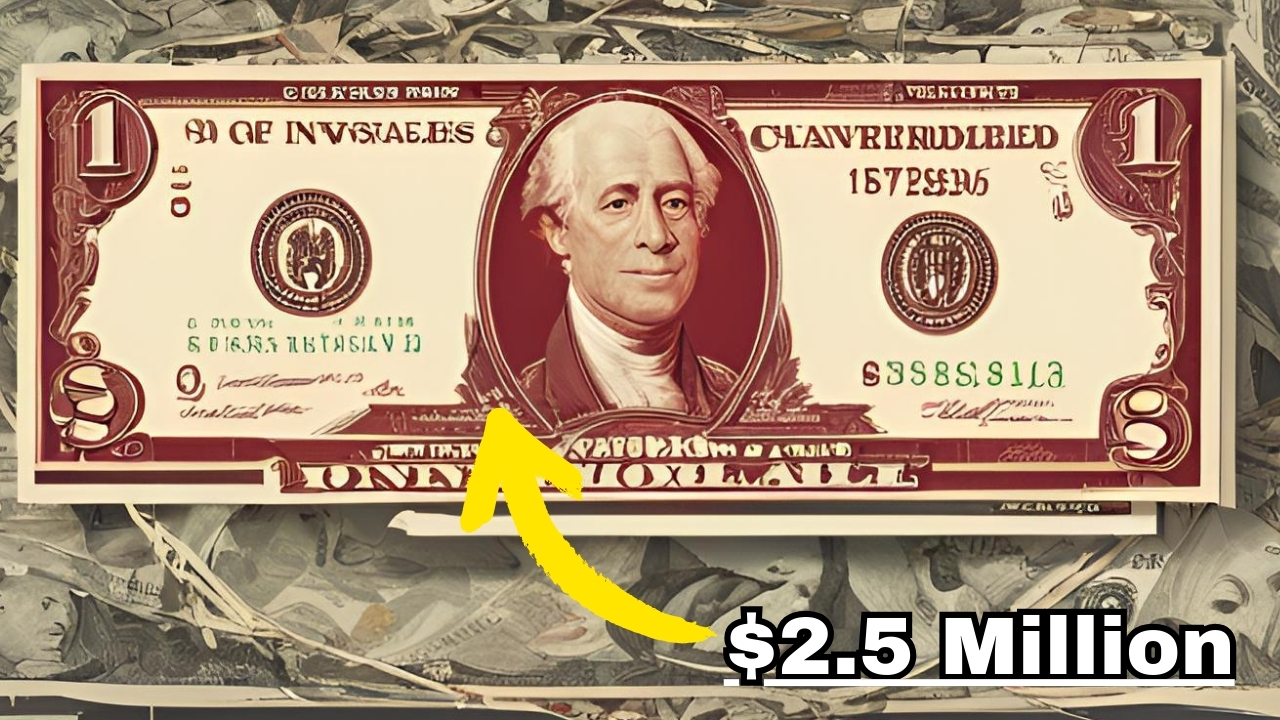Rare $1 Bill: In the captivating universe of numismatics, few treasures compare to the rarest forms of U.S. currency.
While many of us casually spend $1 bills without a second thought, a select few pieces of paper money are so exceptionally rare and valuable that they can fetch millions on the market.
Let’s take a journey into the astonishing world of rare $1 bills, particularly those nearing an eye-opening market valuation of $2.5 million.
These extraordinary artifacts of American history continue to mesmerize collectors and enthusiasts across the globe, with competitive prices reaching new heights in the world of numismatics.
First off, it’s essential to clear up any misconceptions. Contrary to some circulating claims, no $1 bill has actually hit the remarkable $2.5 million mark in the collector’s market.
That said, numerous incredibly rare specimens have approached this amount, and the combined worth of the rarest $1 bills can easily surpass this milestone.
These unique notes are not just about money; they mark significant historical events in the evolution of U.S. currency, transforming them into vital artifacts of our nation’s financial story.
The Grand Watermelon Note: A Distinctive Numismatic Gem
Although it isn’t technically a $1 bill, the crown jewel of American currency is undoubtedly the 1890 Grand Watermelon Note.
This $1,000 bill earned its nickname due to the eye-catching shape of the zeros on its back, which resemble watermelons when viewed from afar.
Back in 2018, one of these stunning notes sold for a jaw-dropping $2.04 million at auction, establishing a world record for paper money.
The exceptional preservation and historical importance of this specific note drove its astronomical value, setting a standard in high-end currency collecting.
Top Dollar Commands for Rare $1 Bills
While no $1 bill has attained the grandeur of the Grand Watermelon Note, several notes have achieved impressive values, each telling its own remarkable story:
1. 1869 $1 “Rainbow” Legal Tender Note
This note is celebrated for its vibrant design, featuring a portrait of Christopher Columbus. In excellent condition, these bills can sell for over $100,000.
The innovative printing methods used for these notes introduced multiple colors to prevent counterfeiting, adding to their allure.
The “Rainbow” nickname comes from the lovely blend of red, blue, and green inks utilized in their printing.
2. 1890 $1 Treasury Note (Ornate Back)
Featuring the image of Edwin Stanton, these notes are coveted for their intricate designs. In untouched condition, they can reach prices upwards of $20,000.
The sophisticated scrollwork and fine engraving represent the highest craftsmanship of 19th-century printing.
Many collectors admire their ornate backs, considered among the most stunning ever created for American currency.
3. 1896 $1 Silver Certificate “Educational Series”
As part of the renowned “Educational Series,” this note showcases an allegorical scene where History instructs Youth. In pristine condition, it can fetch over $10,000.
These artistically rich notes indicate a period in American currency design that favored allegorical figures and intricate symbolic scenes.
The detailed art and historical representation make them especially appealing to both collectors and art aficionados.
4. 1899 $1 Silver Certificate “Black Eagle”
These notes display a powerful image of a spread-winged eagle and are desired by collectors. High-quality specimens can go for over $5,000.
This striking design is patriotic, making the Black Eagle note a recognizable and sought-after item.
The dynamic vignette of an eagle with outstretched wings has turned it into an iconic piece in American currency collecting.
Factors Influencing the Value of Rare $1 Bills
Multiple key elements contribute to the impressive values of these rare $1 bills, each playing a pivotal role in determining their worth:
1. Rarity
The scarcity of these notes, often due to limited print runs or high attrition rates, significantly impacts their value.
Many rare examples are among the few remaining of their kind, making them invaluable to collectors and institutions.
Rarity is arguably the most vital aspect influencing a note’s worth. Notes with limited availability or a history of destruction are inherently more valuable.
Factors affecting a note’s rarity can include its original production numbers, historical preservation conditions, and survival through various economic crises.
Some notes became extremely rare due to government recalls, while others simply faded away due to usual wear and tear.
When only a handful of specimens are known to exist, the connection between rarity and value is vividly illustrated, propelling prices skyward among serious buyers.
2. Condition
The overall condition of a bill has a significant bearing on its price. Uncirculated notes in perfect condition will attract the highest premiums.
Collectors and grading services utilize a detailed scale to assess notes, focusing on paper quality, color consistency, crispness, and any folds, tears, or stains.
Notes that have never been used and retain their original features are especially prized.
Even slight imperfections can heavily impact value, making accurate condition evaluation an essential skill for currency collectors.
Professional grading services provide standardized assessments that help set appropriate market prices, ensuring fair transactions.
3. Historical Significance
Bills linked with notable historical occurrences usually carry added value.
These notes act as physical connections to pivotal moments in American history, from economic upheavals to advancements in printing technology.
Currency issued during significant events, such as wartime emissions or economic reforms, often commands premium values.
The historical backdrop of a note can draw interest from collectors and historians alike, especially when it showcases a crucial moment in monetary policy or design development.
The stories tied to these notes often deepen their allure and value beyond mere physical characteristics.
4. Unique Features
Printing mistakes, special serial numbers, or distinctive designs can immensely boost a bill’s collectible worth.
Error notes, resulting from misprints, frequently become highly desired among specialists.
Serial numbers featuring unique patterns, like repeating digits or special sequences, can bring in significant premiums.
Moreover, notes with experimental print techniques or novel security features frequently attract particular interest from collectors.
These distinct traits make every note unique and can elevate an otherwise common bill into a coveted collectible.
The Quest for Rare Currency
If you feel inspired to hunt for these precious notes, consider these tips:
-
Educate Yourself: Familiarize yourself with different types of currency and how to identify them. This means studying reference books, joining numismatic groups, and connecting with seasoned collectors. Understanding how to spot counterfeits is vital, as is learning about printing styles and historical contexts.
-
Check Your Wallet: While it’s unlikely, a valuable note could still be in circulation. Regularly inspecting the cash you handle might reveal a hidden gem. Look for older notes, unusual serial numbers, and distinctive features that hint at special value.
-
Attend Currency Shows: These events are fantastic venues to encounter rare notes and interact with experienced collectors. Currency shows offer opportunities to view authentic pieces, network with other enthusiasts, and gain insights from vendors and experts. They also provide chances to buy verified notes and expand your collection.
-
Beware of Counterfeits: With rising values comes the risk of forgery. Always confirm authenticity. Teaming up with reputable dealers, utilizing professional grading services, and honing your authentication skills are crucial safeguards against fraud.
The Tomorrow of Rare Currency Collecting
As we transition towards an increasingly digital economy, the charm of rare paper money may grow stronger.
The tangible link to history represented by these notes becomes increasingly significant in our technology-driven age.
The shift towards electronic transactions might ironically enhance the value of physical currency, especially rare pieces symbolizing critical eras in monetary history.
Collectors and investors are increasingly viewing rare currency not only as a hobby but also as a viable store of value.
Conclusion: More Than Just Money
While the notion of a $2.5 million bill might be more fantasy than reality, the universe of rare currency is full of excitement for collectors and history buffs alike.
These valuable paper notes represent not only money; they embody chapters of our nation’s past, chronicling economic transitions, artistic trends, and the lives of historical figures.
Each note conveys its own story, preserved in the intricate artistry and careful craftsmanship that went into its creation.
For the average person, a $1 bill remains just that – a basic form of exchange. Yet for a fortunate few, these rare notes signify the pinnacle of numismatic success, achieving values that elevate simple currency into priceless treasures.
Preserving these historical artifacts ensures that future generations can appreciate the artistry and evolution of American currency.
Whether you’re an established collector or just intrigued by the hidden treasures in your pocket, the domain of rare $1 bills provides a captivating glimpse into the convergence of history, art, and economics.
Who knows? The next time you handle a dollar bill, you just might be clutching a slice of history that’s worth far beyond its nominal value.






